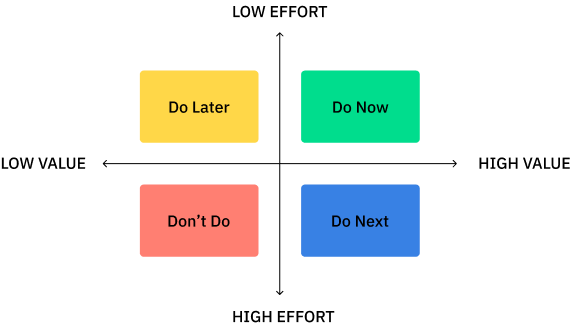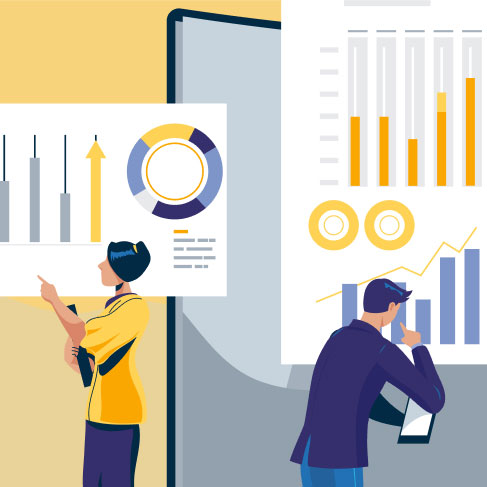A Comprehensive Guide to Build an Effective SaaS Product Roadmap
November 8, 2023 | Read Time : 3 mins
Table of Contents
A meticulously crafted product roadmap can serve as the guiding star, illuminating the path to success. It constitutes the strategic blueprint outlining your product’s journey, aligning it with business objectives and user requisites.
In this comprehensive guide, we will walk you through the step-by-step process of creating a product roadmap that drives results and ensures your SaaS product remains agile, competitive, and relevant.
Understanding Your SaaS Product and Market
Before delving into the intricacies of roadmap creation, gaining an intimate understanding of your SaaS product and the market it serves is imperative. Your product’s unique features and value proposition must be clearly delineated. Engage in rigorous market research, delve into industry trends, and actively seek customer feedback. This comprehensive knowledge will be the bedrock upon which your roadmap is constructed. A profound understanding of your product and market will empower you to make well-informed decisions, ensuring that your roadmap addresses genuine pain points and untapped opportunities.
For instance, consider a project management SaaS tool. Understanding that its value lies in streamlining collaboration and task management can guide feature development toward enhancing these aspects.
Setting Clear Objectives and Goals
A triumphant product roadmap commences with unequivocal objectives and goals. Employ the SMART framework—Specific, Measurable, Achievable, Relevant, and Time-bound—to meticulously define your objectives. For instance, rather than settling for a vague goal like “improve user experience,” aim for something like “increase user engagement by 20% through implementing a streamlined onboarding process within the next six months.” SMART goals provide a clear trajectory and establish criteria for success, leaving no room for ambiguity.
In a Customer Relationship Management (CRM) SaaS context, a SMART goal could be to “reduce customer churn rate by 15% within the next quarter through enhanced customer support features.”
Prioritizing Features and Enhancements
One of the most formidable challenges in roadmap planning lies in feature prioritization. You can use methodologies such as the MoSCoW method or RICE prioritization in this endeavor. Consider customer needs, prevalent market trends, and technical feasibility when determining which features to accord precedence. Striking the right equilibrium ensures that you consistently deliver value and stay at the vanguard of innovation.
Implementing a Kanban board might be prioritized higher for a project management SaaS if user feedback indicates a strong demand for visual task management.

Creating a Visual Representation
Transform your prioritized features into a visual roadmap that is aesthetically appealing, lucid, and easily shareable. Leverage specialized road mapping Software to conjure visually captivating, dynamic representations of your product’s evolutionary journey. A well-articulated visual roadmap serves as a unifying force, aligning your team and stakeholders around a shared vision and fostering collective ownership.
A Gantt chart, for instance, can be an excellent visual representation for a project management SaaS, clearly showing tasks, timelines, and dependencies.
Aligning with Business Goals and User Needs
Your product roadmap should serve as a seamless extension of your overarching business strategy. Verify that each feature and enhancement on your roadmap is inextricably linked to a specific business objective and resonates deeply with user needs. Concentrating on both business and user-centric objectives ensures that your roadmap becomes an integral instrument in realizing your SaaS product’s full potential.
For a CRM SaaS, aligning with business goals could mean focusing on integrating popular email platforms to enhance user convenience and increase adoption.
Incorporating Feedback Loops
Embrace the transformative power of feedback loops. Regularly solicit and assimilate customer feedback, conduct comprehensive user testing, and engage in iterative development. These systematic processes fine-tune your roadmap by allowing you to respond swiftly to evolving user preferences and emerging requirements. Establish robust feedback channels to ensure this flow of invaluable information remains uninterrupted.
A CRM SaaS might conduct user surveys to understand pain points and develop features that directly address those concerns, leading to higher user satisfaction and retention rates.
Adapting to Market Changes
The SaaS landscape is characterized by its perpetual state of flux. To thrive in such an environment, be prepared to pivot when necessary. Keep a vigilant eye on shifting market trends, evolving technologies, and the competitive landscape. Here are some strategies to adapt your roadmap judiciously, all the while preserving focus on your core objectives:
- Continuous Market Research: Regularly conduct thorough market research to stay abreast of emerging trends, changing customer preferences, and evolving technologies. This intelligence will be invaluable in making informed decisions about which features to prioritize and invest in. For instance, a project management SaaS may observe a rising demand for integration with emerging collaboration tools, prompting them to prioritize development in this direction.
- Competitor Analysis: Study your competitors’ product offerings and roadmaps. Identify areas where they might be gaining an edge and consider whether similar features or enhancements should be incorporated into your roadmap. For a CRM SaaS, this could mean swiftly responding to a competitor’s successful implementation of an AI-driven recommendation engine by integrating a similar feature.
- Feedback-Driven Iteration: Leverage customer feedback as a compass for navigating market shifts. Actively seek input through user forums, surveys, and direct conversations. Analyze this feedback to identify pain points and emerging needs. In the case of a task management SaaS, if users express a growing need for advanced reporting features, it might be an opportune time to prioritize this area.
- Scalable Architecture: Design your product with a scalable architecture for rapid adaptation. This ensures that your development team can implement adjustments efficiently when market changes require swift responses. For a CRM SaaS, a scalable architecture would allow for seamless integration with new communication channels or social media platforms as they gain prominence.
Communicating the Roadmap
Effective communication stands as the linchpin of roadmap success. Disseminate your roadmap with unwavering transparency to internal teams, stakeholders, and customers. Here are some additional strategies for effectively communicating your product roadmap:
- Interactive Webinars and Workshops: Host interactive webinars or workshops where you can showcase upcoming features, explain their benefits, and gather direct feedback from users. This keeps your user base engaged and cultivates a sense of involvement in the product’s evolution. For a project management SaaS, a webinar could demonstrate how a new task prioritization algorithm will enhance productivity.
- Release Notes and Documentation: Provide comprehensive release notes and documentation for each update. Clearly outline the new features, enhancements, and any changes in functionality. This empowers users to make the most of the updates and minimizes confusion. In the case of a CRM SaaS, detailed release notes might highlight how a new contact segmentation feature can improve targeted marketing efforts.
- Feedback Loops within the App: Implement in-app feedback mechanisms that allow users to provide input directly from the platform. This makes it convenient for users to share their thoughts while actively engaging with the product. A simple in-app feedback form for a task management SaaS can gather insights on user satisfaction with the newly introduced collaboration features.
- Roadmap Transparency: While it’s important to showcase what’s coming next, also be clear about what might be deprioritized or deferred. Explain the reasons behind these decisions, fostering trust and transparency. For a project management SaaS, this might involve communicating that the integration with a specific third-party tool has been delayed due to unforeseen technical challenges.
- Feedback Acknowledgment and Action: Ensure that users know their feedback is valued. Acknowledge their input and, when applicable, communicate how it has influenced the roadmap. This reinforces the notion that the product is evolving in direct response to user needs. In a CRM SaaS, if a user suggests a feature to streamline lead qualification, acknowledging and implementing their input can strengthen user loyalty.
Monitoring Progress and KPIs
Track an array of Key Performance Indicators (KPIs) pertinent to SaaS product development. Metrics encompassing user engagement, churn rate, and conversion rates offer invaluable insights into how effectively your roadmap is performing. These metrics are beacons of guidance, steering your course toward data-driven refinements and enhancements.
For a CRM SaaS, tracking customer retention rates and Customer Lifetime Value (CLTV) can provide crucial insights into the effectiveness of implemented features.






